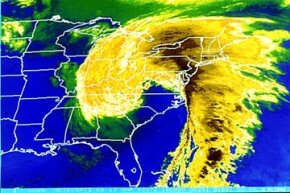This snowstorm was so massive it became a historical event. In terms of storm severity factors, this one had it all: enormous amounts of snow, frigid temperatures, howling winds whipping up monstrous snow drifts — and a widespread area of effect that covered the entire northeastern United States from New England to the Chesapeake Bay, including major metropolitan areas like New York City [source: National Oceanic and Atmospheric Administration]. More than 400 people died during the storm, including more than 100 who were lost at sea.
The storm struck in early March and started out as a serious rainstorm. From Sunday night to Monday morning, the temperature plummeted and the rain turned to snow. In the end, New York City received 22 inches (56 centimeters) of snow, shutting the city down and causing floods when the snow melted. Other places received much more: 58 inches (1.5 meters) of snow in Saratoga Springs, New York, and 45 inches (1.14 meters) in New Haven, Connecticut. Snow drifts as high as 50 or 60 feet (15.2 to 18.3 meters) were reported on Long Island, and wind gusts were reported as fast as 80 mph (128.7 kph).







